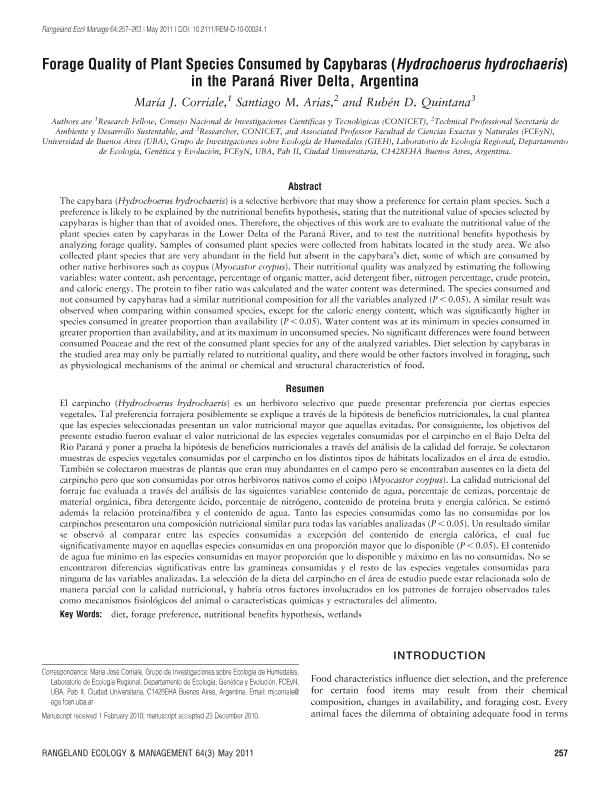Mostrar el registro sencillo del ítem
dc.contributor.author
Corriale, Maria Jose

dc.contributor.author
Arias, Santiago M.
dc.contributor.author
Quintana, Ruben Dario

dc.date.available
2019-01-30T16:48:44Z
dc.date.issued
2011-05
dc.identifier.citation
Corriale, Maria Jose; Arias, Santiago M.; Quintana, Ruben Dario; Forage quality of plant species consumed by capybaras (Hydrochoerus hydrochaeris) in the Paraná River Delta, Argentina; Society for Range Management; Rangeland Ecology and Management; 64; 3; 5-2011; 257-263
dc.identifier.issn
1550-7424
dc.identifier.uri
http://hdl.handle.net/11336/68987
dc.description.abstract
The capybara (Hydrochoerus hydrochaeris) is a selective herbivore that may show a preference for certain plant species. Such a preference is likely to be explained by the nutritional benefits hypothesis, stating that the nutritional value of species selected by capybaras is higher than that of avoided ones. Therefore, the objectives of this work are to evaluate the nutritional value of the plant species eaten by capybaras in the Lower Delta of the Paraná River, and to test the nutritional benefits hypothesis by analyzing forage quality. Samples of consumed plant species were collected from habitats located in the study area. We also collected plant species that are very abundant in the field but absent in the capybara's diet, some of which are consumed by other native herbivores such as coypus (Myocastor coypus). Their nutritional quality was analyzed by estimating the following variables: water content, ash percentage, percentage of organic matter, acid detergent fiber, nitrogen percentage, crude protein, and caloric energy. The protein to fiber ratio was calculated and the water content was determined. The species consumed and not consumed by capybaras had a similar nutritional composition for all the variables analyzed (P < 0.05). A similar result was observed when comparing within consumed species, except for the caloric energy content, which was significantly higher in species consumed in greater proportion than availability (P < 0.05). Water content was at its minimum in species consumed in greater proportion than availability, and at its maximum in unconsumed species. No significant differences were found between consumed Poaceae and the rest of the consumed plant species for any of the analyzed variables. Diet selection by capybaras in the studied area may only be partially related to nutritional quality, and there would be other factors involved in foraging, such as physiological mechanisms of the animal or chemical and structural characteristics of food.
dc.format
application/pdf
dc.language.iso
eng
dc.publisher
Society for Range Management

dc.rights
info:eu-repo/semantics/openAccess
dc.rights.uri
https://creativecommons.org/licenses/by-nc-nd/2.5/ar/
dc.subject
Diet
dc.subject
Forage Preference
dc.subject
Nutritional Benefits Hypothesis
dc.subject
Wetlands
dc.subject.classification
Otras Ciencias Biológicas

dc.subject.classification
Ciencias Biológicas

dc.subject.classification
CIENCIAS NATURALES Y EXACTAS

dc.title
Forage quality of plant species consumed by capybaras (Hydrochoerus hydrochaeris) in the Paraná River Delta, Argentina
dc.type
info:eu-repo/semantics/article
dc.type
info:ar-repo/semantics/artículo
dc.type
info:eu-repo/semantics/publishedVersion
dc.date.updated
2019-01-28T14:13:03Z
dc.journal.volume
64
dc.journal.number
3
dc.journal.pagination
257-263
dc.journal.pais
Estados Unidos

dc.description.fil
Fil: Corriale, Maria Jose. Universidad de Buenos Aires. Facultad de Ciencias Exactas y Naturales; Argentina. Consejo Nacional de Investigaciones Científicas y Técnicas; Argentina
dc.description.fil
Fil: Arias, Santiago M.. Universidad de Buenos Aires. Facultad de Ciencias Exactas y Naturales; Argentina
dc.description.fil
Fil: Quintana, Ruben Dario. Universidad de Buenos Aires. Facultad de Cs.exactas y Naturales. Departamento de Ecología, Genética y Evolución. Grupo de Investigacionesde Ecología de Humedales; Argentina. Consejo Nacional de Investigaciones Científicas y Técnicas; Argentina
dc.journal.title
Rangeland Ecology and Management

dc.relation.alternativeid
info:eu-repo/semantics/altIdentifier/doi/http://dx.doi.org/10.2111/REM-D-10-00024.1
dc.relation.alternativeid
info:eu-repo/semantics/altIdentifier/url/https://www.sciencedirect.com/science/article/pii/S1550742411500302
Archivos asociados
